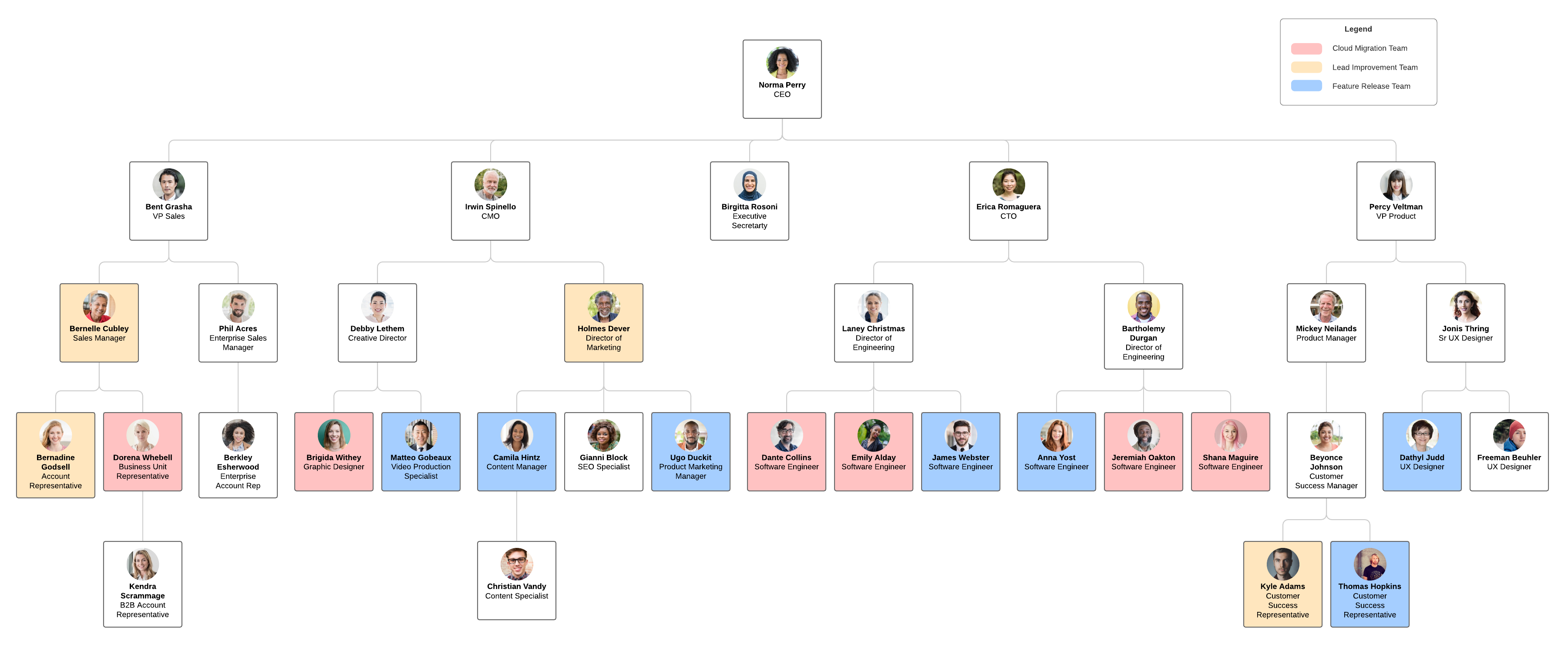Big problems don’t always need big teams to solve them. In fact, small, agile teams of experts are often the key to solving your biggest issues. That’s when you should consider changing up your typical organizational structure and organizing tiger teams.
Next time you’re facing a critical problem, consider forming a tiger team to get in, get out, and get your business back on track.
What is a tiger team?
A tiger team is a specialized, cross-functional team brought together to solve or investigate a specific problem or critical issue.
The term “tiger team” originates from the military and was made famous by NASA who deployed a tiger team during the Apollo 13 mission in 1970. During the Apollo 13 lunar landing mission, part of the service module malfunctioned and exploded. NASA formed a select technical team tasked with solving the issue and bringing the astronauts safely home. This tiger team later won the Presidential Medal of Freedom for their work on that successful mission.
Today, tiger teams are a popular and effective team structure for organizations that need a focused group of experts to manage technical deployments and solve complex issues.
When to build a tiger team
Tiger teams solve a critical issue after the most likely solutions have been attempted. Tiger teams usually focus on important, high-profile, high-impact, critical projects. In other words, you wouldn’t form a tiger team to tackle your regular day-to-day projects.
Tiger teams may address projects that are failing or blocked in some way, or they could work on new projects developed in response to opportunities with high potential (i.e., high revenue or business potential).
Once the project is complete, the members of the tiger team disperse and return to their original departments and roles.
Who makes up a tiger team?
Who you assign to your tiger team will depend on the team’s objective and the problem to solve. However, a tiger team will typically include a small variety of subject-matter experts (often senior-level) from business development, operations, finance, legal, engineering, and often sales and marketing.
Keep in mind that while this is a team of specialists, each person should have a broad range of skills. By building a roster of the best of the best, you reduce skills gaps and blind spots and increase agility. Including team members with hyper-nuanced specialties without broader experience can lead to bloated headcounts and slower maneuvering.
You will also want to assign a corporate sponsor to the group to help secure any needed resources, funding, and additional personnel throughout the project.
Why use a tiger team?
Tiger teams have several advantages that make them an appealing option when critical issues arise.
They are made up of mature experts who understand the problem (including the risks and stakes), know what to do and how to do it, and work well with other people and departments. Tiger teams are also small and cross-functional, so they can make and act on decisions with both speed and precision.
Because of their cross-functional expertise, tiger teams can approach a problem from multiple perspectives and understand how it all integrates, making it easier to identify and focus on the most critical and high-priority items.
How to form an effective tiger team
Follow these steps to build your tiger team.
1. Identify the problem to solve
Before you form your tiger team, you first have to identify what problem they will tackle. Do you need a team to streamline a technology deployment? Or maybe there’s an important project that is over-budget and under-delivered that threatens your client experience.
Evaluate your business needs and opportunities to assess which projects or priorities could use the expertise and agility of your tiger team.
2. Clarify the needed skills and experience
Once you know what problem you’re trying to solve, you can figure out what skills or expertise you need to address those issues.
A highly technical project may require a tiger team with an engineering or tech-heavy background, while a broader business issue might need the combined experience of team members from more diverse roles across the organization. The nature of the project will direct how focused or broad the skillsets are in your tiger team.
3. Identify your key players
Based on the skills and experience needed for your project, identify who in your organization has the expertise to fill the limited tiger team roster. Tiger team candidates are often easy to spot—they tend to be employees or contractors with maturity in the industry and seniority in the organization. In other words, they aren’t rookies.
In smaller companies, creating a shortlist is usually quick and easy. However, if you are part of a larger organization, narrowing down the list can be trickier.
Lucidchart can help you identify and assign team members where their skill sets will have the most impact. Import employee data to automatically generate an org chart, use conditional formatting to highlight preferred skills or roles, and switch to a view of your tiger teams with smart containers. Learn more about making an org chart.

And if you haven’t already, consider drafting a staffing plan. A staffing plan can help you map out your organization and discover what experience your staff currently has and uncover any existing skills gaps. Understanding your organization’s staffing levels is the first step to understanding and identifying your organization’s greatest personnel assets.
The tiger team approach
With your tiger team in place, you are ready to hit the ground running. To give your team the best chance of success and increase their effectiveness in the field, follow these steps.
- Observe and document symptoms and their impact.
- Identify possible causes.
- Develop tests to validate those causes.
- Decide which tests to perform based on organizational priorities.
- Conduct testing until the root cause is confirmed.
- Outline possible solutions.
- Agree on a solution and implement it.
- Document results.
This approach helps keep your team on track and maximize results.
Common mistakes to avoid
Although tiger teams are ostensibly your “best of the best,” they may still run into obstacles or mistakes that can slow progress and hinder their effectiveness. Here are a few common mistakes to watch out for when running a tiger team.
No strategic direction
The team needs to approach every problem strategically to ensure resource optimization and overall effectiveness. Without a clear understanding of the problem and a strategic approach, the team will bounce around chasing different symptoms and solutions.
Failure to define the problem and all its symptoms clearly
In order to solve a problem, the team has to understand the problem and all its symptoms clearly. Each person should be aligned in their understanding and have equal access to information so that everyone is working from the same knowledge base.
Scope creep
The team may initially focus on the original problem, but discussions can wander and veer off into other issues that may be related but are not central to the task at hand. Scope creep distracts the team from the core problem and the ideal solutions for it, slowing progress and wasting resources.
Lack of documentation
One of the benefits of a tiger team is their ability to drill down to the root cause of an issue and solve it at the foundation. But if the team doesn't document their processes, solutions, and learnings, your organization can’t capitalize on that work.
Tiger teams are a great way to address critical issues with speed and agility. Use these tips to maximize your team’s effectiveness and keep your organization running smoothly.

Use Lucidchart org charts to form the perfect cross-functional team.
Pick an org chart templateAbout Lucidchart
Lucidchart, a cloud-based intelligent diagramming application, is a core component of Lucid Software's Visual Collaboration Suite. This intuitive, cloud-based solution empowers teams to collaborate in real-time to build flowcharts, mockups, UML diagrams, customer journey maps, and more. Lucidchart propels teams forward to build the future faster. Lucid is proud to serve top businesses around the world, including customers such as Google, GE, and NBC Universal, and 99% of the Fortune 500. Lucid partners with industry leaders, including Google, Atlassian, and Microsoft. Since its founding, Lucid has received numerous awards for its products, business, and workplace culture. For more information, visit lucidchart.com.
Related articles
Why your company should incorporate tiger teams
When launching a new product, redesigning an organization, or implementing new processes, your company may require a tiger team of experts to see it through. Read how tiger teams add value to your organization.
10 types of organizational structures (+ org charts for implementation)
The typical org chart looks like a pyramid, but not every company functions along a hierarchical organizational structure. Let’s go through the 10 common types of org structures and reasons why you might consider each of them.
Top strategies for managing cross-functional teams
Creating truly cross-functional teams is a tall order, but project managers who embrace the challenge will see a great payoff.
5 keys to effective cross-functional collaboration
Cross-functional collaboration brings multiple teams together from within your organization, working towards a shared goal. This enables teams to connect silos and overcome communication barriers. By creating agile, focused workplaces, teams are able to adapt to changes and address issues faster.

